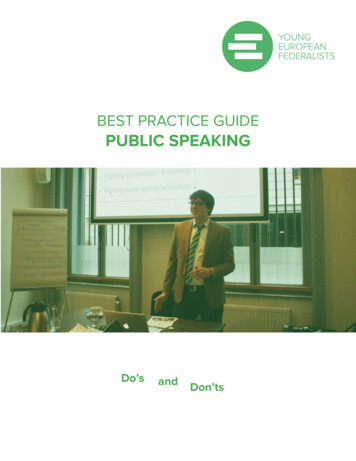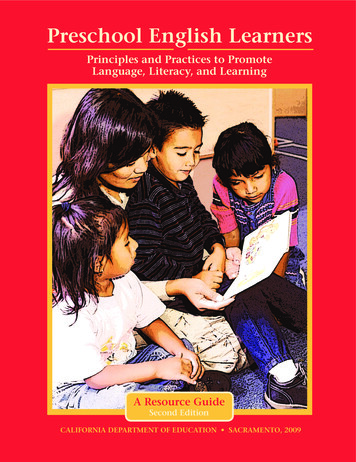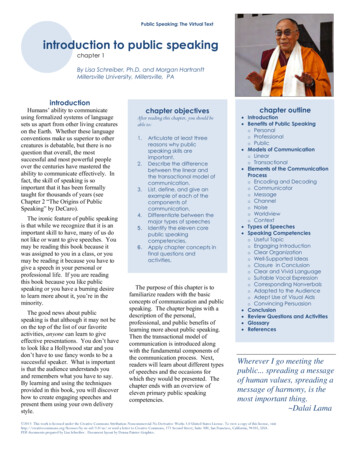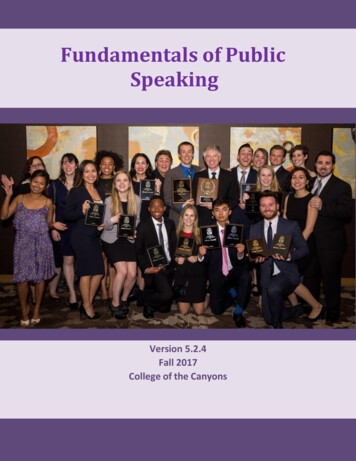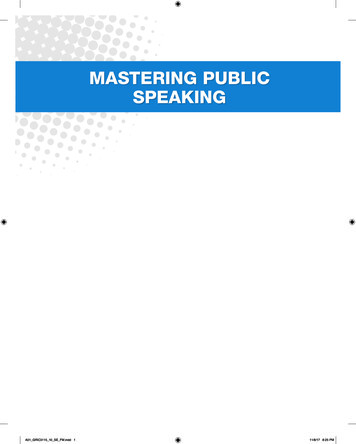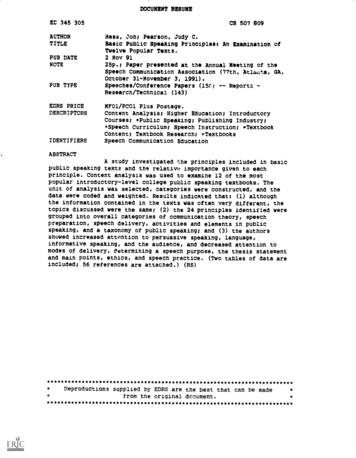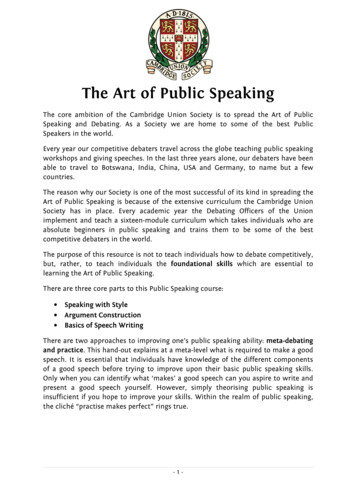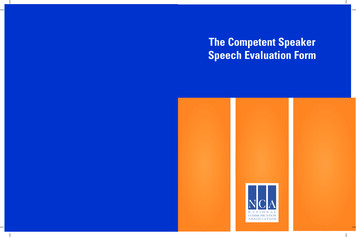
Transcription
The Competent SpeakerSpeech Evaluation Form
The Competent SpeakerSpeech Evaluation FormSecond EditionEdited By Sherwyn MorrealeMichael MooreDonna Surges-TatumLinda Webster
All NCA Publication Program materials are reviewed within the spirit of academic freedom, promoting the free exchangeof ideas. The contents of this publication are the responsibility of its authors and do not necessarily reflect the officialpolicies or positions of the National Communication Association, its members, its officers, or its staff. 2007 National Communication Association. All rights reserved.Brief portions of this publication may be copied and quoted without further permission with the understanding thatappropriate citations of the source will accompany any excerpts. A limited number of copies of brief excerpts maybe made for scholarly or classroom use if:1. the materials are distributed without charge or no fees above the actual duplication costs are charged;2. the materials are reproductions, photocopies, or copies made by similar processes, and not reprints or republications;3. the copies are used within a reasonable time after reproduction;4. the materials include the full bibliographic citation: and5. the following is also clearly displayed on all copies: “Copyright by the National Communication AssociationReproduced by permission of the publisher.”This permission does not extend to situations in which:1. extensive amounts of material are reproduced or stored in an electronic or similar data retrieval system,2. a fee above actual duplicating costs is charged or if there exists a reasonable expectation of profit, or3. the material is reproduced or reprinted for other than scholarly or educational purposes.In such cases, permission must be obtained prior to reproduction and generally a reasonable fee will be assessed. Requests for permission to reproduce should be addressed to the Publications Manager.National Communication Association1765 N Street, NWWashington, D.C., 20036Library of Congress Catalog Card Number:ISBN: 0-944811-13-2
“The Competent Speaker”Speech Evaluation Form and Manual, 2nd EditionThe Competent Speaker Speech Evaluation Form is a standardized and tested instrument to be used in assessing public speakingcompetency at the higher education level. The instrument was developed in 1990 by the NCA Committee for Assessment andTesting (now the NCA Division on Communication Assessment) and representatives of 12 academic institutions. This secondedition retains the competencies and evaluative criteria from the first edition but the manual is updated to reflect more timelyconstructs and literature regarding the instrument and its use. The instrument can be used: (a) to evaluate informative andpersuasive speeches in class; (b) for testing-in or testing-out (placement) purposes; (c) as a tool for instructing and advisingstudents; and (d) to generate assessment data for departmental or institutional accountability.NCA Non-Serial Publication SeriesGust Yep, EditorSan Francisco State UniversityThe NCA Non-serial Publications (NSP) Program publishes book-length projects focusing on theoretical and/or pedagogicalissues related to the study and practice of human communication in a variety of contexts. Projects grounded in social scientific,interpretive, critical, performance, and rhetorical approaches and methodologies are included. Diverse views of communicationranging from microscopic (e.g., social cognition, affect and emotion in communication) to macroscopic (e.g., public discourse,systems of representation) are also included. Topics that have been central to the history of the discipline as well as those thathave been marginalized and excluded in the discipline are included as are projects with an inclusive, interdisciplinary, and socialjustice agenda.
Table of ContentsI. INTRODUCTION . . . . . . . . . . . . . . . . . . . . . . . . . . . . . . . . . . . . . . . . . . . . . . . . . . . . . . . . 7II. FACT SHEET FOR THE COMPETENT SPEAKERSPEECH EVALUATION FORM . . . . . . . . . . . . . . . . . . . . . . . . . . . . . . . . . . . . . . . . . . . . . 8III. SIGNIFICANT CHARACTERISTICS OF THESPEECH EVALUATION FORM . . . . . . . . . . . . . . . . . . . . . . . . . . . . . . . . . . . . . . . . . . . . . 9IV. THE COMPETENT SPEAKER SPEECH EVALUATION FORMSAtomistic . . . . . . . . . . . . . . . . . . . . . . . . . . . . . . . . . . . . . . . . . . . . . . . . . . . . . . . . . . . . . . . . 10Holistic Form. . . . . . . . . . . . . . . . . . . . . . . . . . . . . . . . . . . . . . . . . . . . . . . . . . . . . . . . . . . . . . 11V. EIGHT PUBLIC SPEAKING COMPETENCIES AND CRITERIAFOR ASSESSMENT . . . . . . . . . . . . . . . . . . . . . . . . . . . . . . . . . . . . . . . . . . . . . . . . . . . . . . 12VI. LOGISTICS, ADMINISTRATION, AND USE OF THE INSTRUMENT . . . . . . . . . . . 16Training in the Use of the Form . . . . . . . . . . . . . . . . . . . . . . . . . . . . . . . . . . . . . . . . . . . . . . . 16Using the Form to Evaluate and Grade Speeches . . . . . . . . . . . . . . . . . . . . . . . . . . . . . . . . . . 16Scoring System Options for the Form . . . . . . . . . . . . . . . . . . . . . . . . . . . . . . . . . . . . . . . . . . 17Potential Uses of the Form . . . . . . . . . . . . . . . . . . . . . . . . . . . . . . . . . . . . . . . . . . . . . . . . . . . 17Cautions Regarding the Use of the Form . . . . . . . . . . . . . . . . . . . . . . . . . . . . . . . . . . . . . . . . 17Eight Steps for Inter-Rater(s) Reliability Training . . . . . . . . . . . . . . . . . . . . . . . . . . . . . . . . . 18VII. APPENDICES, DOCUMENTATION IN SUPPORT OF THE INSTRUMENT . . . . . . 19A. Background and Need for the Competent Speaker Speech Evaluation Form . . . . . . . . . . 20B. The Instrument Development Process . . . . . . . . . . . . . . . . . . . . . . . . . . . . . . . . . . . . . . . . 24C. Reliability, Validity, and Bias Testing . . . . . . . . . . . . . . . . . . . . . . . . . . . . . . . . . . . . . . . . 26D. NCA Criteria for the Assessment of Oral Communication . . . . . . . . . . . . . . . . . . . . . . . . 33E. The Competent Speaker Compliance with NCA Criteria for Assessment . . . . . . . . . . . . . 38VIII. BIBLIOGRAPHY . . . . . . . . . . . . . . . . . . . . . . . . . . . . . . . . . . . . . . . . . . . . . . . . . . . . . . . . . 39The Competent Speaker Speech Evaluation Form v
ACKNOWLEDGEMENTSMany communication scholars and academic institutions and organizations were responsible for the original development and testing of The Competent Speaker Speech Evaluation Form. The editors of this second edition acknowledge the contributions of the following colleagues: The original subcommittee of public speaking experts who searched the literature and carefully developed the original speech evaluation form and its criteria. Conrad Awtry, University of Wisconsin;Jim Bradford and Faye Clark, DeKalb College; Nancy Christ, University of Nebraska; Pat Comeaux,University of North Carolina; Jean DeWitt, University of Houston; Mike Moore, Purdue University,Calumet; Sherry Morreale, University of Colorado; Phil Taylor, University of Central Florida; KarolynYocum, Missouri Southern State College. The NCA Committee on Assessment and Testing (now the NCA Division on Communication Assessment) and its chair, Phil Backlund, who organized the 1990 NCA Conference on Communication Competency Assessment, where plans for The Competent Speaker Evaluation Form were germinated. Statisticians Don Morley of University of Colorado at Colorado Springs and Donna Tatum of Universityof Chicago, who performed the initial psychometric tests of the speech evaluation form. University of Colorado at Colorado Springs, its communication department, faculty and staff who provided moral support and labor to help develop the instrument and its manual. The National Communication Association, its staff, and the NCA Non-Serial Publication Series, all ofwhom supported the development and testing of the original instrument as well as the production andpublication of this second edition.vi The Competent Speaker Speech Evaluation Form
I. INTRODUCTIONThe Competent Speaker Speech Evaluation Formwas created to provide a statistically valid and reliabletool for the assessment of public speaking performance.It is an instrument designed for evaluating specific public speaking skills. Thus, the focus is on the assessmentof both verbal and nonverbal behaviors characteristicof competent public speaking as opposed to knowledgeabout, or motivation to engage in, public speaking. Theinstrument can serve several purposes: (a) evaluatingany type of speeches in class; (b) testing-in or testingout (placement) purposes; (c) as a tool for instructingand advising students about the preparation and presentation of public speeches; and (d) generating assessmentdata for accountability-related objectives of academicinstitutions.The Competent Speaker assessment instrumentconsists of eight public speaking competencies, fourrelating to preparation and four to delivery. For each ofthe eight competencies, a set of specific performancecriteria is provided for three levels of performance: unsatisfactory, satisfactory, and excellent. Because eachcompetency is assessed with respect to appropriatenessfor the audience and occasion, cultural and other biasesare overcome. The eight competencies and corresponding performance criteria provide a comprehensive description of oral communication competency for thepublic speaking context.Impetus for developing The Competent SpeakerEvaluation Form originated during the NCA 1990Summer Conference on Communication CompetencyAssessment. At that conference, a subcommittee of theCommittee on Assessment and Testing was charged to:develop the public speaking skills portion of a testof oral communication. A position should be takenon which skills should be assessed, what criteriashould be used to assess them, and suggested proce-dures. Perhaps prototypes should be developed andrecommended. (Backlund, 1990a, p.1)Eleven geographically-dispersed communicationscholars determined this charge to be the developmentof a speech performance evaluation tool groundedin and driven by the communication competency andpublic speaking literature in the communication discipline. The subcommittee of 11 reviewed a large bodyof literature regarding speech evaluation and oral communication competency, synthesized that literature,and developed and tested the instrument presented inthis manual. This second edition of The CompetentSpeaker includes the following enhancements: Results of new psychometric testing are presentedin Appendix C.A holistic version of the instrument is presentedimmediately following the original instrument.The competency on supporting materials nowincludes electronic as well as non-electronic presentational aids.The academic literature and bibliography on competent public speaking are updated.For ease of use, this manual begins with a brief factsheet and a list of significant characteristics of TheCompetent Speaker. These are followed by a copy ofthe speech evaluation form itself, in atomistic and holistic style, and the eight competencies, including theperformance criteria for each competency. Next, guidelines are provided for using the instrument to assessspeakers’ performances and to train speech raters in itsuse. For the reader interested in the background, rationale, development process, and psychometric testing ofthe form, information regarding each of these issues iscontained in the appendices, along with a bibliographyof relevant literature.The Competent Speaker Speech Evaluation Form 7
II. THE COMPETENT SPEAKERSPEECH EVALUATION FORM FACT SHEETBackgroundThe Competent Speaker was developed in 1990 bya subcommittee of the NCA Committee on Assessmentand Testing (now the NCA Division on Communication Assessment) charged to develop and test a communication competency-based speech evaluation form(Backlund, 1990). Development and testing involvedrepresentatives of 12 academic institutions, and thesubcommittee was chaired by Sherwyn Morreale ofUniversity of Colorado at Colorado Springs, MichaelMoore of Purdue University, Calumet, and Phillip Taylor of University of Central Florida. Information regarding the instrument’s development and testing in the1990’s as well as current testing for this second editionis found in Appendices B and C in this manual.tion and four to delivery. For each of the eight competencies, specific criteria for assessment are provided atthree levels of performance: excellent, satisfactory, andunsatisfactory. The instrument is presented on pages 11(atomistic form) and 12 (holistic form) in this manual;the criteria begin on page 13.ConceptualizationThe instrument was derived from NCA’s Speakingand Listening Competencies for High School Graduates(1982); NCA’s Communication is Life: Essential College Sophomore Speaking and Listening Competencies(Quianthy, 1990); and the public speaking competencies contained in the Communication Competency Assessment Instrument (Rubin, 1982a).PurposeThe instrument is to be used to assess public speakingcompetency at the higher education level, for purposesof in-class speech evaluation, entrance/exit placementand assessment, as an instructional strategy or advisingtool, and/or to generate assessment data for institutionalor departmental accountability.The instrument assesses public speaking behaviors,as opposed to knowledge/cognition and motivation/affect. Further, it assesses molecular/specific behaviors asopposed to molar/general traits. That said, the speechevaluator may make inferences about knowledge/cognition and motivation/affect from observing the publicspeaking behaviors of a speakerRationaleDespite the proliferation of public speaking coursesand evaluation forms, no standardized and psychometrically tested speech evaluation form was availableprior to 1990. Nor has there been such a form availablegrounded in the discipline’s conceptualization of publicspeaking competency. Thus, The Competent Speakerwas developed to address that need for a standardizedand tested speech evaluation form.Technical CharacteristicsThe Competent Speaker consists of eight publicspeaking competencies, four of which relate to prepara-8 The Competent Speaker Speech Evaluation FormTraining ManualThis manual provides guidelines for instructors totrain one or more speech raters/evaluators. Training instructions for use of the instrument begin on page 21.The manual’s appendix also provides background information for administrators who may need to providea rationale for using the instrument.Scoring ProcedureUtilize the instrument as a ratio scale by using anynumerical weighing system, between and within theeight competencies, that suits the purpose of the evaluator and the particular speech event. For example, assignment of 1 to unsatisfactory, 2 to satisfactory, and 3to excellent, for each of the eight competencies, wouldresult in a possible score range of 8 (unsatisfactory) to24 (excellent) for a given speech.Reliability/Validity/BiasThe Competent Speaker was developed with greatconcern for its psychometric reliability and validity andfor biases of any kind and is determined to be a reliable, valid, and useful instrument with which to judgespeeches. Appendix C contains the results of the original testing process as well as testing performed for inclusion in this second edition.
III. SIGNIFICANT CHARACTERISTICS OFTHE SPEECH EVALUATION FORMEvery effort was made to ensure that this instrumentis consistent with research and literature in the communication discipline concerning the nature of communication competence and current policy concerning its assessment. A few of the more significant characteristicsof The Competent Speaker instrument relevant to thisobjective include the following:1. Assesses public speaking behavior. In recognitionof the impracticality of assessing all domains ofcompetence, the instrument focuses exclusivelyon the assessment of public speaking “behaviors.”Thus, it is not designed nor does it purport tomeasure either knowledge/cognition about publicspeaking or affect/motivation for public speaking.Regardless, as with the assessment of any behavior, the instrument may permit one to make limited inferences about the knowledge, motivation,and critical thinking skills of the speaker, inferences limited at most to the particular speakingevent. However, such inferences should be madewith caution since any reliability or validity associated with the instrument’s assessment of behavior does not apply to its assessment of knowledgeor motivation.2. Assesses both verbal and nonverbal behavior.The instrument identifies competencies for verbaland nonverbal behavior and provides criteria forassessing competence in the use of each. However, assessment is limited to the public speaking context and should not be generalized to othercontexts, e.g., dyadic, group, etc.3. Does not assess molar/general traits. The instrument does not directly assess molar/general traitssuch as charisma, dynamism, audience contact,etc. Rather, the assessment of these traits is implied through the rating of molecular/specific behaviors such as communicating thesis, vocal variety, eye contact, etc.4. Provides a holistic assessment of remote preparation skills. The instrument will provide a holisticassessment of the speaker’s remote preparation5.6.7.8.9.skills. However, additional procedures or instruments will be required to assess specific remotepreparation skills (e.g., specific research or outlining skills). Of course, the results of preparationskills, as assessed in the first four competencies,can be observed to some extent as the speech ispresented.Does not assess listening skills. The instrument isdesigned for the assessment of “speaking” skillsonly. Listening skills should be assessed by instruments and procedures designed for that purpose.Provides for either an atomistic or holistic assessment. The eight discreet competency statementswith their corresponding criteria primarily provide for an atomistic/analytic assessment. However, neither the competency statements nor theircorresponding criteria prevent assessment basedupon a holistic impression. For this purpose, a holistic version of the instrument is included in thissecond edition.Assesses degree of competence. The criteria foreach competency describe degrees of competenceat the unsatisfactory, satisfactory, and excellentlevels. An assessment can be made of either orboth the degree to which the speaker possesseseach competency and the degree to which thespeaker possesses public speaking competence ingeneral.Provides descriptions of “competent” responsesas anchors. Each of the eight competency statements is accompanied by a descriptive statementof the criteria for judging each of the three degrees of competence.Is free of cultural bias. Each competency is assessed with respect to the target audience and occasion. In other words, judgments are based uponthe degree to which the behavior is appropriate tothe “audience and occasion.” As long as the evaluator/assessor bases judgments on these criteria,cultural bias should not become a factor.NOTE: The purchaser of this manual is permitted to copy the speech evaluation form and the criteria for the competencies presented on the following pages in order to carry out any speech performance evaluation. With the purchaseof the manual from NCA, any instructor or department or institution may reprint as many copies of the speech evaluation form as are needed by that instructor, department, or institution, without further permission of NCA.The Competent Speaker Speech Evaluation Form 9
IV. The NCA Competent Speaker Speech Evaluation FormCourse: Semester: Date: Project:Speaker(s):PRESENTATIONAL COMPETENCIESRATINGSUnsatisfactory Satisfactory ExcellentCompetency One: CHOOSES AND NARROWS A TOPIC APPROPRIATELYFOR THE AUDIENCE & OCCASIONCompetency Two: COMMUNICATES THE THESIS/SPECIFIC PURPOSEIN A MANNER APPROPRIATE FOR THE AUDIENCE & OCCASIONCompetency Three: PROVIDES SUPPORTING MATERIAL (INCLUDING ELECTRONICAND NON-ELECTRONIC PRESENTATIONAL AIDS) APPROPRIATE FOR THEAUDIENCE & OCCASIONCompetency Four: USES AN ORGANIZATIONAL PATTERN APPROPRIATE TO THETOPIC, AUDIENCE, OCCASION, & PURPOSECompetency Five: USES LANGUAGE APPROPRIATE TO THE AUDIENCE& OCCASIONCompetency Six: USES VOCAL VARIETY IN RATE, PITCH, & INTENSITY(VOLUME) TO HEIGHTEN & MAINTAIN INTEREST APPROPRIATE TO THEAUDIENCE & OCCASIONCompetency Seven: USES PRONUNCIATION, GRAMMAR, & ARTICULATIONAPPROPRIATE TO THE AUDIENCE & OCCASIONCompetency Eight: USES PHYSICAL BEHAVIORS THAT SUPPORT THE VERBALMESSAGEGeneral Comments:Summative Scores of Eight Competencies:10 The Competent Speaker Speech Evaluation Form
The NCA Competent Speaker Holistic Speech Evaluation FormCourse: Semester: Date: Project:Speaker(s):RATINGSUnsatisfactory Satisfactory ExcellentPREPARATION AND CONTENT Chooses and narrows topic appropriately Communicates thesis/specific purpose Provides appropriate supporting material (includes presentational aids) Uses an effective organizational patternPRESENTATION AND DELIVERY Uses language appropriately Uses vocal variety in rate, pitch, and intensity Uses appropriate pronunciation, grammar, and articulation Uses physical (nonverbal) behaviors that support the verbal messageGeneral Comments:Summative Score:The Competent Speaker Speech Evaluation Form 11
V. EIGHT PUBLIC SPEAKING COMPETENCIESAND CRITERIA FOR ASSESSMENTCompetency OneCHOOSES AND NARROWS A TOPIC APPROPRIATELY FOR THE AUDIENCE & OCCASION.EXCELLENTThe speaker presents a topic and a focus that are exceptionally appropriate for the purpose, time constraints, and audience.[That is, the speaker’s choice of topic is clearly consistent with the purpose, is totally amenable to thetime limitations of the speech, and reflects unusually insightful audience analysis.]SATISFACTORYThe speaker presents a topic and a focus that are appropriate for the purpose, time constraints, and audience.[That is, the speaker’s choice of topic is generally consistent with the purpose, is a reasonable choice forthe time limitations of the speech, and reflects appropriate analysis of a majority of the audience.]UNSATISFACTORYThe speaker presents a topic and a focus that are not appropriate for the purpose, time, the constraints oraudience.[That is, the speaker’s choice of topic is inconsistent with the purpose, the topic cannot be adequately treatedin the time limitations of the speech, and there is little or no evidence of successful audience analysis.]Competency TwoCOMMUNICATES THE THESIS/SPECIFIC PURPOSE IN AMANNER APPROPRIATE FOR THE AUDIENCE & OCCASION.EXCELLENTThe speaker communicates a thesis/specific purpose that is exceptionally clear and identifiable.[That is, there is no question that all of the audience members should understand clearly, within the opening few sentences of the speech, precisely what the specific purpose/thesis of the speech is.]SATISFACTORYThe speaker communicates a thesis/specific purpose that is adequately clear and identifiable.[That is, at least a majority of the audience should understand clearly, within the opening few sentencesof the speech, precisely what the specific purpose/thesis of the speech is.]UNSATISFACTORYThe speaker does not communicate a clear and identifiable thesis/specific purpose.[That is, a majority of the audience may have difficulty understanding, within the opening few sentencesof the speech, precisely what the specific purpose/thesis of the speech is.]12 The Competent Speaker Speech Evaluation Form
Competency ThreePROVIDES SUPPORTING MATERIAL (INCLUDING ELECTRONIC AND NON-ELECTRONICPRESENTATIONAL AIDS) APPROPRIATE TO THE AUDIENCE & OCCASION.EXCELLENTThe speaker uses supporting material that is exceptional in quality and variety.[That is, supporting material is unarguably linked to the thesis of the speech, and further is of such quality that it decidedly enhances the credibility of the speaker and the clarity of the topic.]SATISFACTORYThe speaker uses supporting material that is appropriate in quality and variety.[That is, supporting material is logically linked to the thesis of the speech, and is of such quality that itadds a measurable level of interest to the speech.]UNSATISFACTORYThe speaker uses supporting material that is inappropriate in quality and variety.[That is, supporting material is only vaguely related to the thesis of the speech, and variety is either toogreat or too little to do anything but detract from the effectiveness of the speech.]Competency FourUSES AN ORGANIZATIONAL PATTERN APPROPRIATETO THE TOPIC, AUDIENCE, OCCASION, & PURPOSE.EXCELLENTThe speaker uses an exceptional introduction and conclusion and provides an exceptionally clear andlogical progression within and between ideas.[That is, the introduction clearly engages the audience in an appropriate and creative manner, the body ofthe speech reflects superior clarity in organization, and the conclusion clearly reflects the CONTENT ofthe speech and leaves the audience with an undeniable message or call to action.]SATISFACTORYThe speaker uses an appropriate introduction and conclusion and provides a reasonably clear and logicalprogression within and between ideas.[That is the introduction clearly engages a majority of the audience in an appropriate manner, the bodyof the speech reflects adequate clarity in organization, and the conclusion reflects adequately the contentof the speech and leaves a majority of the audience with a clear message or call to action.]UNSATISFACTORYThe speaker fails to use an introduction or conclusion and fails to provide a reasonably clear and logicalprogression within and among ideas.[That is, the introduction fails to engage even a majority of the audience in an appropriate manner, the bodyof the speech reflects lack of clarity in organization, and the conclusion fails to reflect adequately the content of the speech and fails to leave even a majority of the audience with a clear message or call to action.]The Competent Speaker Speech Evaluation Form 13
Competency FiveUSES LANGUAGE APPROPRIATE TO THE AUDIENCE & OCCASION.EXCELLENTThe speaker uses language that is exceptionally clear, vivid, and appropriate.[That is, the speaker chooses language that enhances audience comprehension and enthusiasm for thespeech, while adding a measure of creativity that displays exceptional sensitivity by the speaker for thenuances and poetry of meaning.]SATISFACTORYThe speaker uses language that is reasonably clear, vivid, and appropriate.[That is, the speaker chooses language that is free of inappropriate jargon, is nonsexist, is nonracist,etc.]UNSATISFACTORYThe speaker uses unclear or inappropriate language.[That is, the speaker chooses inappropriate jargon or language which is sexist, racist, etc.]Competency SixUSES VOCAL VARIETY IN RATE, PITCH, AND INTENSITY (VOLUME) TO HEIGHTENAND MAINTAIN INTEREST APPROPRIATE TO THE AUDIENCE & OCCASION.EXCELLENTThe speaker makes exceptional use of vocal variety in a conversational mode.[That is, vocals are exceptionally and appropriately well-paced, easily heard by all audience members,and varied in pitch to enhance the message.]SATISFACTORYThe speaker makes acceptable use of vocal variety in a conversational mode.[That is, the speaker shows only occasional weakness in pace, volume, pitch, etc., thereby not detractingsignificantly from the overall quality or impact of the speech.]UNSATISFACTORYThe speaker fails to use vocal variety and fails to speak in a conversational mode.[That is, the speaker shows frequent weakness in controlling and adapting pace, volume, pitch, etc., resulting in an overall detraction from the quality or impact of the speech.]14 The Competent Speaker Speech Evaluation Form
Competency SevenUSES PRONUNCIATION, GRAMMAR, AND ARTICULATIONAPPROPRIATE TO THE AUDIENCE & OCCASION.EXCELLENTThe speaker has exceptional articulation, pronunciation, and grammar.[That is, the speaker exhibits exceptional fluency, properly formed sounds which enhance the message,and no pronunciation or grammatical errors.]SATISFACTORYThe speaker has acceptable articulation, with few pronunciation or grammatical errors.[That is, most sounds are properly formed, there are only minor vocalized disfluencies, and a few (1-2)minor errors in pronunciation and grammar.]UNSATISFACTORYThe speaker fails to use acceptable articulation, pronunciation, and grammar.[That is, nonfluencies and disfluencies interfere with the message, and frequent errors in pronunciationand grammar make it difficult for the audience to understand the message.]Competency EightUSES PHYSICAL BEHAVIORS THAT SUPPORT THE VERBAL MESSAGE.EXCELLENTThe speaker demonstrates exceptional posture, gestures, bodily movement, facial expressions, eye contact, and use of dress.[That is, kinesic (posture, gesture, facial expressions, eye contact) and proxemic (interpersonal distanceand spatial arrangement) behaviors and dress consistently support the verbal message and thereby enhance the speaker’s credibility throughout the audience.]SATISFACTORYThe speaker demonstrates acceptable posture, gestures, facial expressions, eye contact, and use ofdress.[That is, kinesic (posture, gesture, facial expressions, eye contact) and proxemic (interpersonal distanceand spatial arrangement: behaviors and dress generally support the message, with minor inconsistenciesthat neither significantly distract from the speaker’s credibility with the audience nor interfere with themessage.]UNSATISFACTORYThe speaker fails to use acceptable posture, gestures, facial expressions, eye contact, and dress.[That is, kinesic (posture, gesture, facial expressions, eye contact) and proxemic (interpersonal distanceand spatial arrangement) behaviors and dress ar
public speaking context. Impetus for developing The Competent Speaker Evaluation Form originated during the NCA 1990 Summer Conference on Communication Competency Assessment. At that conference, a subcommittee of the Committee on Assessment and Testing was charged to: develop the public speaking

